Roaches can infest bathrooms just as easily as kitchens. However, it seems strange that these pests can find that room at all. It’s not like bathrooms have direct access to the outdoors. Likewise, they rarely have more than a single window. Before you can get rid of the cockroaches, you need to figure out how roaches got into your bathroom.
Cockroaches enter bathrooms by crawling up through drains, finding gaps in baseboards, squeezing through leaky pipes, sliding under doors, and through small holes in walls or ceilings. Sometimes, cockroaches enter through other parts of the house and travel to the bathroom, attracted by the water and humidity.
You can’t pour anything down your drain to kill roaches. Bleach, insecticide, vinegar, and baking soda aren’t a quick fix. Instead, pour boiling water down the drain to clear out any roaches. After that, repair any entry points that the roaches use and do what you can to reduce the humidity in your bathroom.
Why Are Cockroaches In My Bathroom?
Bathrooms are naturally attractive to roaches. They offer all the key elements a roach needs to thrive. This includes:
Water
Be it from your shower, toilet, or sink, bathrooms are damp places. Cockroaches will drink from these sources.
Good Hiding Spaces
Cockroaches understand that they’re prey animals. They will tuck themselves into hiding places when there’s any activity from larger creatures. Bathrooms offer many hiding places, such as:
- Cabinets
- Behind the toilet
- Trash cans
- Shelves and products on the shelves
- Areas of the shower
- Beneath the bathtub
Even the smallest hole is accessible to be a roach. Some species can squeeze through holes 1/6th their body size.
Heat
Your shower will create a steamy, warm environment on a semi-regular basis. Cockroaches thrive in warm climates. If other areas of your home are cold, the bathroom will seem like an ideal place to live.
Potentially Food
Though less ideal than a kitchen, bathrooms provide alternative food sources. This may include:
- Toothpaste
- Soap
- Toilet paper
- Skin products that contain chocolate, cream, or mud
- Used sanitization items, like ear swabs or feminine hygiene products.
Darkness
In most parts of the house, windows are open, and the lights are on. In contrast, bathrooms tend to be dark. When there is less human activity, roaches are left alone and undisturbed. That’s just how they like it.
As you can see, bathrooms are a paradise for cockroaches. If they have an opportunity to nest themselves into this space, they will. That can leave you wondering how they managed to get in.
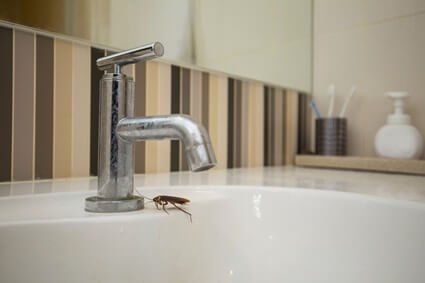
How Roaches Enter Bathrooms
There are many ways that roaches enter bathrooms, and not all of them are apparent to homeowners. They may have entered your bathroom directly, not passing through the rest of your home. Likewise, they could have manipulated a structural gap in your home. If you find cockroaches in the bathroom, consider these entry points:
Pipes
Drains and pipes are a common way for roaches to enter homes. If damaged, leaking, or cracked, pipes can provide unguarded access between the indoors and outdoors. What may seem like a minor nick in your sewage pipe may be open season to roaches.
Once inside, pipes offer a highway for cockroaches. They can explore the entirety of your home, manipulating other leaks to gain access. As the bathroom is where most of your plumbing leads, roaches will come through your drains.
In apartment buildings, damaged pipes can become an even bigger issue. An infestation from one apartment can easily travel through to another via a shared wall. If a neighbor ignores an infestation, roaches can expand their population to your home. If your neighbor runs out of food, roaches will make your space the next target.
Neighbors fumigating can also cause roaches to migrate to your space. Pipes will aid them as gateways to new havens.
Cracks Or Holes In the Walls
As homes age, it’s common for holes or cracks to develop on their exterior. The trimming, foundation skirt, paneling, or corners may develop small fissures. If they escalate, this can result in leaking and structural damage. However, a cockroach will only need a small gap to enter your bathroom.
That’s was made clear by International Pest Control, where it was found that a fully-grown American cockroach could squeeze through spaces as small as 3 mm. It’s natural to overlook a crack that small.
Tiles And Baseboards
Within the home, consider the tiles and baseboards of your bathroom. A cockroach will squeeze through little gaps in the foundation. Tiling eases this process, as small cracks won’t ruin the entire square but can provide a gap. Those broken edges can also serve as hiding spaces.
Wooden baseboards are prone to warping and breakage when exposed to water and steam. When properly installed, baseboards in the bathroom should hold up for a significant amount of time. However, constant exposure to showers will eventually warp wooden baseboards. It doesn’t matter how water-resistant the coating is.
Gaps Under Doors
Of course, a cockroach might enter the house through another area entirely. Once inside, it could travel to the bathroom. Your kitchen may be well-kept and properly cleaned. When robbed of that easy food source, cockroaches will find the bathroom appealing.
To gain entry, a roach may exploit gaps under the doors. Cracks under the door might also increase the chance of roaches finding the bathroom.
Roaches Coming Through The Toilet
So, we’ve determined that cockroaches come through bathroom pipes. Are cockroaches going to come through your toilet? Can cockroaches move up from the sewers and into your house?
It’s a popular myth and can leave you afraid to use the bathroom. It’s entirely unfounded.
Why Roaches Can’t Invade Your Toilet
All modern toilets have a water trap. This comes in the form of a pipe at the base of your toilet. This water trap is made to stop gasses from coming up from the sewer line to the inside of a tank.
The water trap is, like its name implies, filled with water. This effectively creates a seal around gasses to stop them from rising. If a roach did scuttle through the pipe, it would have to tread a lot of water to enter your toilet. It’s likely to drown before this, assuming it could even work up the strength.
So, what if you witness a cockroach in your toilet? Then this is a rare exception, but it may have two explanations:
- Your toilet isn’t fitted with a trap
- You have a clogged toilet
Both cause bad odors to come up from the toilet and into your bathroom. If you don’t have a trap, this odor comes directly from the sewer system. Likewise, if your toilet is clogged, that allows roaches to bypass the water trap. These odors are toxic, so you should correct the issue.
Why Are Dead Roaches In My Toilet?
If you notice a dead roach floating in your toilet bowl, it’s likely that a roach was already in your bathroom. It may have tried to enter the toilet for water or to hide and fell in. Depending on the texture or material of your toilet bowl, it may have been unable to escape and drowned.
Cockroaches can last several minutes without oxygen. It’s difficult to drown them. So, if you’ve used the bathroom recently and the roach body is new? Then the roach may have been exposed to poison and died as it tried to drink.
Do Cockroaches Come from Sewers?
Sewers are home to many pests, and bathrooms are directly connected to sewer systems. That can lead you to believe that a cockroach infestation in your bathroom means that you have a problem with your sewage system or tank. It’s far more likely that cockroaches:
- Sought out your home
- It came through small breaks in the pipes
- Found a gap in your drain exposed under your home’s foundation
Are There Roaches Only In The Bathroom?
If you only see cockroaches in your bathroom, it’s unlikely that your infestation is contained in that area. In fact, roaches are often found in bathrooms because there are many places to get trapped. If a roach falls into a bathtub, it may be unable to get out. Likewise, it may struggle with the slippery walls of:
- Sinks
- Showers
- Pipes
I Saw One Cockroach, Should I Be Worried?
One or two roaches should not be taken lightly. A single cockroach often indicates several more cockroaches.
Likewise, your bathroom isn’t the only appealing spot in your home. If you think roaches have only infested your bathroom, you may limit your efforts to that spot. That allows other infestation points to thrive out of sight.
With that said, one roach doesn’t necessarily mean you have a full-blown infestation. The key is to act quickly. There’s still a chance to exterminate them before it develops into a large-scale problem.
Roaches Coming Out of Bathroom Drain
It’s unnerving to see a roach crawl out of the bathroom drain. Even scarier is when it climbs out of shower or bathtub drains when you’re expecting to take a bath. These cases are hard to deal with because:
- Drains can be hard to clean
- The inner pipes are out of reach
So, how can you get rid of the cockroaches and prevent them from returning?
What Do You Pour Down The Drain To Get Rid Of Cockroaches?
The internet is full of rumors and urban myths. You may turn to bleach, vinegar, or insecticides. However, using the wrong solution might:
- Damage your pipes
- Fail to remove the infestation
By dispelling your best guesses and popular myths, you can get results.
Bleach
Bleach is a corrosive chemical. While bleach can be used to kill roaches, it can do more damage to your pipes. The solution will eat away at the metal, plastic, and other materials. This could result in more cracks or fissures in your drain, leading to even more cockroaches. That’s if it doesn’t burst your pipes entirely.
As such, bleach should not be used to remove cockroaches from drains. If you have nothing else and are feeling desperate, be sure to dilute the substance with water. It won’t be effective, but it will cause less damage.
Insecticide
Insecticides will kill roaches. However, most brands are designed to be sprayed on pests or to fumigate your home. Pouring it down the drain may produce no results or only bad ones.
That’s because insecticides are highly toxic. Putting a whole can down a drain will not just harm roaches. It will damage other organic material around it. It can leach into nearby water sources, into the ground, and your sewer system.
According to the Journal of Economic Entomology, various studies note that insecticides can stay in the soil for up to 3 years. In some areas, it may even be illegal to dump insecticides down the pipes.
Vinegar And Baking Soda
Vinegar and baking soda are touted as a home remedy for clogged pipes and a way to eradicate cockroaches. Baking soda and vinegar, when mixed, will lead to a foaming reaction. That supposedly clears clogs and harms roaches. In reality, this reaction is small. It won’t harm roaches nor dissolve oils.
Compared to bleach, it isn’t harmful. Rumor has it that the reaction of vinegar and baking soda creates too much pressure. This could burst your pipes. In reality, that isn’t true, as the reaction is relatively tame.
Boiling Water
If cockroaches scuttle up your bathroom drain, use boiling water. Unlike bleach or insecticides, hot water will not destroy your pipes. Likewise, it won’t leech into the water or the ground. Water at a rolling boil, upon contact, will kill roaches just as effectively as bleach.
With that said, there are a few caveats to this method. Hot water is only effective as long as it’s boiling. When poured down a drain, especially during cold weather, it can quickly turn cold. When roaches are at the bottom of the drain, the water may not be hot anymore by the time it reaches them.
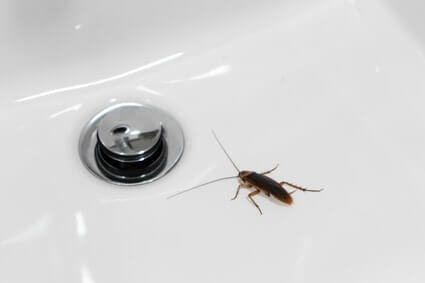
Roaches In Bathroom At Night
When visiting the bathroom at night, you don’t want to find roaches. If it happens more than once, that can lead you to wonder if the bathroom is more appealing to cockroaches at night. Roaches love dark places.
Dark
Of all areas of the house, your bathroom likely to be the darkest because there are fewer windows. Any windows that exist are likely fogged-glass to limit their transparency, making it harder for light to get through.
Humid
If you shower just before bed, your bathroom will be left steamy. This will be an ideal haven for moisture-loving cockroaches. People are also less likely to leave their windows open at night, allowing the steam to remain in the bathroom for longer than it would in the mornings and afternoons.
Quiet
A cockroach is a smart prey animal that knows to flee from danger. Most danger will first be detected through sounds. As such, cockroaches will like how quiet your bathroom is at night.
Living rooms often have electronics whirling away. Your kitchen may have the sound of a refrigerator humming in the night. In your bedroom, snoring, tossing and turning, or the rustling of sheets are all notable sounds. However, a bathroom rarely has any noise at all. This makes it a safe area for cockroaches to hide.
Why Are There Cockroaches In My Shower?
Cockroaches enjoy showers for the same reasons they enjoy the bathroom as a whole. They may come up the drains because of gaps in the pipes. They may enjoy the water source. They may have slipped and been unable to climb out.
Any hair that gathers in the drain will be a feast. As a protein-rich organic material, cockroaches will consume it. While it’s not as appealing as human food, roaches are scavengers and opportunistic eaters. Forgetting to clean the hair out of your drain may have motivated the roaches to seek out your shower for a meal.
How To Prevent Roaches from Entering Bathrooms
Roaches are sometimes inevitable in bathrooms, especially if you live in a warm area. However, you can reduce the chances of cockroaches entering with these steps:
Clean Your Bathroom
Cockroaches will thrive in an unclean bathroom. To name a few, they’ll have access to:
- Moist corners
- Mildew
- Skin cells
However, a clean bathroom isn’t enough to repel roaches. You must remove and safely store items that attract roaches.
Soap Bars
Roaches will eat soap bars due to their high oil content. More natural or organic varieties may also contain animal fat. If you have a soap bar, consider placing it in a secured container. Alternatively, you can switch to liquid soap.
Toilet Paper
Likewise, toilet paper should be kept in its own container. Ideally, it will be stored in the package it came in until needed. Roaches are attracted to paper, and toilet paper especially so. Not only is it a source of food, but roaches can spread bacteria on it.
Hair
Remove decomposing hair from drains as cockroaches will eat this organic material.
Trash
Secure trash bins so that roaches can’t easily get in. This may involve buying a more secure lid, removing your bin from a dark corner, or getting better bags.
Add Water Traps To Sinks
All modern toilets are required to have a water trap. You can also install them in other drains as well. P, J, U, and S water traps work well to deter roaches. What’s more, adding these traps can help you avoid clogs, too.
Fix Pipes
When dealing with leaky pipes, make sure the fix is complete and permanent. Partially repaired drains or pipes will crack during cold months. That’s also a prime season for cockroaches to seek a warm haven.
You can fix your pipes DIY or with professional help. If you’re waiting on a plumber, seal the pipe temporarily using a clamp or epoxy putty. Otherwise, your infestation can worsen until the pipe is sealed. Aside from leaking pipes, actual gaps in the plumbing can be an issue, so:
- Be sure to patch the gap between pipes and surrounding areas.
- Insulate and tape off gaps between piping and walls.
- You can also add false cupboards or false cabinet backings to stop roaches from entering through gaps.
Repair Cracks And Holes
Other than broken pipes, walls and floors should be maintained. Small cracks in wooden walls, baseboards, and tiles should be caulked and patched up. Even the smallest cracks can house roaches. To keep your bathroom pest-free, regularly perform a maintenance check-up. At least once a year, inspect:
- Tiles
- Floors
- Ceilings
- Walls
You should pay close attention to corners, where roaches like to frequent. Likewise, watch out for spaces where the wall meets with the floors and ceilings.
Remove Sources of Humidity
Anything that keeps moisture in your bathroom can attract roaches. To keep humidity at bay, consider:
- Adding a dehumidifier
- Installing a bathroom fan
This will lessen its appeal to cockroaches and help avoid mold, too.
Another constant source of moisture is a bathroom mat. It should not be kept damp on the floor, especially if it’s thick or shaggy. Always hang it up to dry after use, or moisture can collect in and around it.
In a bathroom, cockroaches won’t lack water sources. The mat itself won’t appeal to them, but it’s a prime environment for growing mold and bacteria. Consider antibacterial bath mats or even mold- and mildew-resistant.
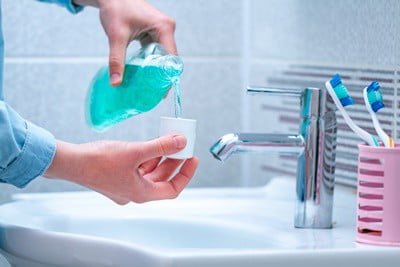

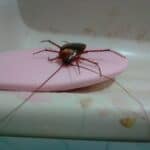
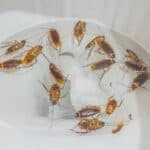
Thanks you for all this information! Renters are in a tricky situation, as we can only do so much ourselves regarding repairs. I hate cockroaches more than just about anything, but today was the fourth time in three years that I have found a cockroach in the bathroom (floor or tub) — whereas I never saw any in the first fifteen years I lived in this apartment. I keep the drains shut all the time. I wish there was a better, sure-fire way to keep the pests out.